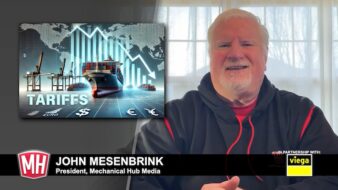FAQ: Water Heating Systems
by Rich Grimes
Welcome back to another edition of FAQ! This article will respond to common questions related to water heating systems. There are many variables involved with water heating such as electricity, gas, combustion, ventilation, exhaust and so on.
DISSOLVED OXYGEN
The effect of dissolved oxygen in the water supply and its reaction to heat comes up frequently. Water is composed of hydrogen and oxygen. Cold water will hold more oxygen than hot water and when water is heated, the oxygen will escape. The best analogy is when a pan of cold water is heated to a boil. As the water heats up it becomes cloudy. Before reaching a boiling point, oxygen bubbles form on the bottom of the pan. As the heating surface transfers more heat, water temperature in the pan increases and amount the escaping air bubbles increase.
The effects of dissolved oxygen will increase as the ground water temperature decreases. It is more noticeable in winter months where the incoming ground water drops in temperature. Dissolved oxygen cannot hurt you and it does not take very long for the cloudy water to clear up. Once the oxygen escapes, the water becomes clear in appearance.
Dissolved oxygen can be more acute on a new heater installation and can also be exacerbated by aerators. New heaters have a clean heating surface that transfers heat very effectively and efficiently. New electric resistance heating elements can also make some noise as the oxygen bubbles will form on the hot element. An elevated tank temperature can help to ‘burn off” the oxygen bubbles as a thin film of scale will begin to form on the element surface. This thin film prevents the oxygen bubbles from direct contact with the element surface and the high-pitched squeal goes away.
FUEL SOURCE COMPARISON
I am often asked to explain what products are the most efficient in their class and how they compare to each other as far as operating costs. A good comparison is to look at residential products and what would could be used in that application. The DOE label indicates an estimated yearly cost to operate the heater on its designated fuel source, using an average fuel cost. The heaters are rated with an Energy Factor (EF).
Standard electric water heaters are rated at an average of .92 EF. They have higher EF ratings than a gas heater but they have a higher energy cost. The Hybrid Heat Pump is the newest electric technology that employs a dedicated heat pump. It is rated at an incredible 2.4 EF that makes it one of the least expensive ways to heat water.
Standard gas fired tank-type heaters have an average EF rating of approximately .58 EF. Higher efficiency tank-type units range from about .60 to .76 EF. Condensing tank-type heaters like the State Premier Power Vent are at the top of this class at with thermal efficiency rating of 96% or approximately .93 EF.
Standard Tankless heaters have a mid-range efficiency that is typically .82 to .84 EF. Condensing Tankless heaters and Hybrid Gas heaters range from about .88 to .95 EF.
Let’s compare a 50-Gallon heater and see what this all means…
HEATER / EF DOE YEARLY
FUEL TYPE RATING COST TO OPERATE
Standard Electric .91 $514
High Efficiency Electric .95 $492
Hybrid Heat Pump Electric 2.4 $201
Standard Gas .60 $315
High Efficiency Gas .70 $261
Condensing Gas Tank-Type .93 $233
Standard Tankless Gas .82 $224
Condensing Tankless Gas .91 $202
Solar 10.1 SEF* $154
*Solar systems are rated with a Solar Energy Factor (SEF)
As you can see, there are many options and levels of efficiency that are available. Each category has fuel saving technology that can be employed. I always remind customers that fuel costs will only go up over time, not down.
EQUIVALENT PIPE LENGTHS
It can be confusing when calculating a vent piping or gas piping arrangement. Equivalent pipe lengths refers to the total footage of piping AND fittings. If a heater is rated to vent at a maximum of 100′ of equivalent vent, we must consider the elbows in our calculation. In a 4″ size vent system, each elbow is counted as 5′ equivalent. If we have (4) 90° elbows on a particular vent system, it will be counted as 20′ of vent. We can only have 80′ of straight pipe plus the 20′ for the elbows for a maximum equivalent length of 100′.
The attached gas fitting chart indicates the equivalent lengths of fittings based on pipe size. The larger the fitting, the more equivalent length.
FLEXIBLE GAS CONNECTORS
Many gas supply issues center around undersized flexible connectors. Flexible gas connectors are rated for a certain amount of BTU’s, based on length and ID (Inside Diameter). Many connectors will have full size threaded ends but reduced tubing. A connector with ¾” ID will have a larger hose that is approximately 1″ OD (Outside Diameter).
Each rated gas connector has a label attached that indicates how much gas it can flow based on its length. Always read the label and make sure that the connector you are installing can carry as many BTU’s as the appliance you are connecting to.
GAS TANKLESS VENTING
Gas tankless heaters use Category III Stainless Steel, non-corrosive, sealed vent material. When a customer upgrades from a tank-type atmospheric heater is when this comes up. Atmospheric gas heaters are Category I rated and use a double wall metal vent. It is not a sealed system and it is constructed of a galvanized exterior with an aluminum liner.
The question is “Can I use the existing Type B vent and tie in the new tankless heater to it?”. The answer to this question is NO. The tankless heater has a positive draft and it creates condensation in the venting. It will create an extremely hazardous condition and erode the Type B vent. It will leak combustion products at the joints and into the building, creating a potential for injury or death from carbon monoxide. NEVER use an existing Type B vent for anything other than a Category I appliance. Know and plan to replace the vent system if you are removing a standard gas tank-type heater and replacing it with a tankless heater. Condensing tankless heaters typically use PVC, CPVC or ABS pipe for vent material. Check the heater’s rating label and installation manual for approved vent materials.
GAS PRESSURE REQUIREMENTS
Gas fired appliances are considered as low-pressure operation. Low pressure Natural can be summarized as a gas requirement at the appliance inlet of 7″ Water Column (.25 PSI) minimum and 14″ Water Column (.5 PSI) maximum. LP Gas is typically a delivery pressure at the appliance of 11″ Water Column minimum and 14″ Water Column maximum. ANSI listings have slightly lower ratings as a safety factor (example: they list the maximum as 13.5″ WC). A lot of newer appliances will operate on lower gas inlet pressures.
It is important to remember that Natural and LP Gas are delivered at higher pressures (typically 2 to 35 PSI) and MUST be regulated down to supply the appliances. This can be a Single-Stage regulator for the entire piping system or it can be Two-Stage regulation.
We thank you for taking the time to read this article and we hope you find it helpful. We will see you in a future article!




Join the conversation: